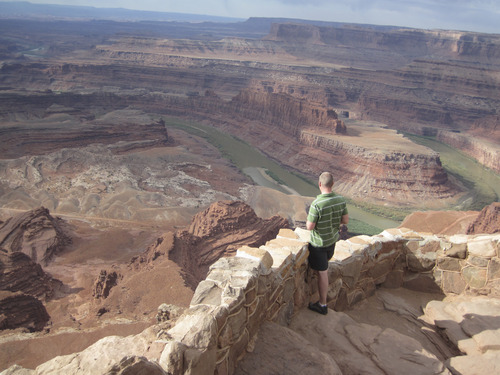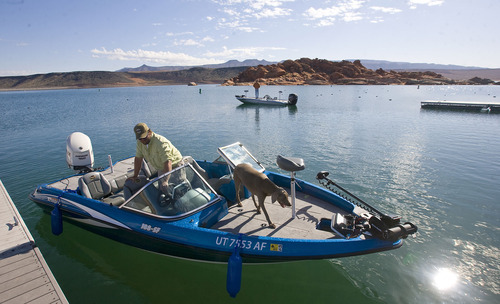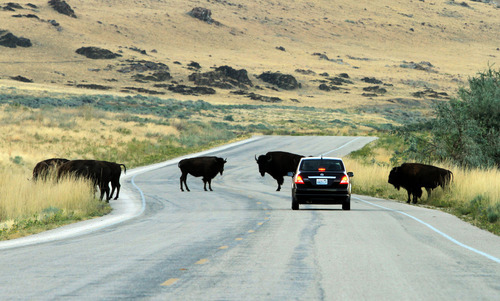This is an archived article that was published on sltrib.com in 2011, and information in the article may be outdated. It is provided only for personal research purposes and may not be reprinted.
Utah might have been the last state to establish a Parks and Recreation Commission, but the newly minted organization began in the late 1950s with four original state parks and some grand ideas.
A 1959 report to then-Utah Gov. George Clyde laid out three impressive objectives:
• To provide personal enjoyment to residents and future generations.
• To increase tourism and gain associated economic benefits.
• To boost state coffers through taxes that flow from increased tourist and vacation traffic.
The report also quoted then-U.S. Assistant Secretary of Commerce Henry Kearns on the value of financing a program that initially identified 118 potential state parks.
"Tourism is a miraculous cake that you can eat and still have," Kearns said. "When a country exports its products, it is drawing on its reserves of natural resources. But no matter how much tourism draws on natural resources, they never wear out. The sun still shines on golden beaches, water still courses over its falls and historic monuments remain intact. The tourist enjoys these and takes nothing away from them but his memories."
The agency that would become the Utah Division of Parks and Recreation now manages 43 state parks. Starting with the original four parks – Territorial Statehouse in Fillmore, This Is the Place in Salt Lake City, Camp Floyd and Old Stagecoach Inn in Utah County and Dixie (now Snow Canyon, near St. George) — Utah's state park system grew gradually.
Some parks, including Fort Buenaventura, Minersville and the Jordan River Par 3 golf course, were given to local governments in 2002.
Parks often were established with support of legislators and local officials where they were located. The eight state historical museums were built on or near the areas or buildings they were preserving. Scenic parks such as Dead Horse Point and Goblin Valley were on land either donated by counties or sold or transferred to Utah by the federal Bureau of Land Management.
Most of the water-oriented recreation parks were built by the federal Bureau of Reclamation and then turned over to Utah State Parks to manage.
As legislators contemplate closing some parks due to budget constraints, they could face problems because 22 of the parks were largely or partly acquired with federal Land and Water Conservation Funds, which require the lands to be protected forever as public outdoor recreation areas. An additional 12 parks were part of the Recreation and Public Purposes Act administered by the Bureau of Land Management. If those parks close, the act requires that title to the land revert to the federal government.
wharton@sltrib.com
Twitter: @tribtomwharton
View Utah State Parks in a larger map
—
State park founding dates
1957 • This Is the Place Heritage Park, Territorial Statehouse.
1958 • Camp Floyd/Stagecoach Inn
1959 • Dead Horse Point, Hyrum, Utah Field House of Natural History
1962 • Bear Lake, East Canyon/Mormon Flat, Goosenecks, Palisade, Snow Canyon (earlier named Dixie State Park)
1963 • Coral Pink Sand Dunes, Kodachrome Basin, Piute
1964 • Steinaker
1965 • Green River, Otter Creek, Scofield
1966 • Huntington, Rockport, Willard Bay
1968 • Wasatch Mountain
1969 • Antelope Island
1970 • Anasazi, Gunlock, Utah Lake, Yuba
1971 • Deer Creek, Millsite
1972 • Starvation
1973 • Iron Mission, Jordan River OHV
1974 • Goblin Valley
1976 • Escalante
1978 • Edge of the Cedars, Great Salt Lake Marina
1986 • Quail Creek
1987 • Fremont Indian
1988 • Red Fleet
1992 • Historic Union Pacific Rail Trail
1995 • Jordanelle
2003 • Sand Hollow
2006 • Flight Park
Source • Utah State Parks —
How Utah state parks were acquired
Museums/heritage parks • All are on or near where cultural sites were discovered. Anasazi, Fremont and Edge of the Cedars are authentic archaeological sites. Utah Field House and Frontier Homestead are dedicated to preserving the prehistory and history of the surrounding area. Camp Floyd and Territorial Statehouse preserve original buildings and structures where they were built. Museums are generally established by the Legislature to be administered by State Parks.
Bureau of Reclamation parks • Eleven of the parks are Bureau of Reclamation reservoirs where public recreation facilities are managed as Utah State Parks. Contracts with third parties allocating state responsibilities for periods greater than one year require prior federal approval. These include Steinaker, Red Fleet, Starvation, Deer Creek, East Canyon, Willard Bay, Jordanelle, Rockport, Hyrum, Scofield and Huntington.
Scenic parks • Kodachrome Basin, Dead Horse Point, Escalante, Goosenecks, Antelope Island, Goblin Valley and Snow Canyon were in most cases identified as gems and either donated by counties or sold or transferred by the Bureau of Land Management to the state.
Land and Water Conservation Fund parks • Under this federal grant program, the funded site must be protected forever as a public outdoor recreation area and the property cannot be converted without federal approval. The 22 parks that were partially or completely acquired with these funds include Antelope Island, Bear Lake, Dead Horse Point, Deer Creek, East Canyon, Flight Park, Fremont Indian, Great Salt Lake Marina, Green River, Huntington, Hyrum, Jordan River OHV, Otter Creek, Palisade, Sand Hollow, Scofield, Snow Canyon, Starvation, Utah Lake, Wasatch Mountain, Willard Bay and Yuba.
Recreation and Public Purposes Act parks • The 12 parks acquired in this manner were transferred to Utah by the Bureau of Land Management. They will revert back to federal ownership if land is not used for the purposes for which it was acquired. The title may by transferred only with the consent of the BLM. Parks in this category include Bear Lake, Coral Pink Sand Dunes, Dead Horse Point, Escalante, Goblin Valley, Goosenecks, Gunlock, Kodachrome Basin, Otter Creek, Snow Canyon, This is the Place and Wasatch Mountain.
Sources • Utah State Parks, Office of the Legislative Auditor General









